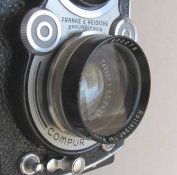johnielvis
Member
- Joined
- May 21, 2010
- Messages
- 966
- Format
- Medium Format
I just thought of this and I just tested it. It works on the viewing lens so it'll work on the taking lens.
What you need is a TLR and a rolleinar set that fits it. Not just any old rolleinar, though, the olde school kind that come in three pieces.
What you do is take the prism part "the rolleiparkiel" ONLY and pop that on the taking lens to compose. rotate it to get the amount of shift or rise/fall you need--it's a fixed amount depending if it's a #1, #2 or #3 rolleinar. remember that position--take it off the front and pop it on the taking lens in the same position. shoot with your rise/fall/shift. Repeat as often as you want.
Pretty good, huh?
Try it yourself! Run to your camera! Mount that rolleiparkiel and rotate it around! SEE the shift rotate with it! ENJOY newfound FREEDOM!
What you need is a TLR and a rolleinar set that fits it. Not just any old rolleinar, though, the olde school kind that come in three pieces.
What you do is take the prism part "the rolleiparkiel" ONLY and pop that on the taking lens to compose. rotate it to get the amount of shift or rise/fall you need--it's a fixed amount depending if it's a #1, #2 or #3 rolleinar. remember that position--take it off the front and pop it on the taking lens in the same position. shoot with your rise/fall/shift. Repeat as often as you want.
Pretty good, huh?
Try it yourself! Run to your camera! Mount that rolleiparkiel and rotate it around! SEE the shift rotate with it! ENJOY newfound FREEDOM!






